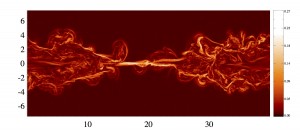Predicting solar assaults

Three-dimensional kinetic simulations of magnetic reconnection reveal turbulence generation, which was not evident in two-dimensional simulations. The turbulence could play a fundamental role in forecasting space weather.
The simplest statistical approach describes a plasma with fluid equations, “like the flow around an airplane, but with additional forces from the electric and magnetic fields,” Daughton explains. A relatively large system can be studied with this approach, but it depends on making approximations, some of which might be invalid.
For example, a fluid model of plasmas works well for most of a system, except where the magnetic field lines get very close together. In these so-called thin regions, the model breaks down. “We are debating what physics causes this,” Daughton says.
Instead of treating the plasma only as a fluid, researchers looked at particle characteristics in a kinetic model. “A fully kinetic model makes fewer assumptions than a fluid one,” Daughton says. It’s essentially a statistical description of the plasma working from first-principles (fundamental physical laws).
Since magnetic reconnection tends to occur in thin areas, scientists want to “couple the dynamics of the large scale to those thin areas,” says Vadim Roytershteyn, a plasma physicist at SciberQuest in Del Mar, Calif. “To obtain the full description, one must simultaneously resolve the large-scale dynamics and the tiny layers.”
Daughton, Karimabadi and Roytershteyn took this new thinking – plus the three-dimensional kinetic plasma simulation code called VPIC – to the Cray XK6 at Oak Ridge National Laboratory. The Department of Energy’s Innovative and Novel Computational Impact on Theory and Experiment (INCITE) program provided 37 million processor hours for the work.
There were intriguing results. Karimabadi says the team found that starting with a 2-D system that is purely laminar – smooth, rather than turbulent – it stays laminar even after magnetic reconnection. When the team ran the simulation in 3-D, the system self-generated turbulence. “Turbulence can increase the mixing efficiency,” he says, “and space weather is all about mixing of the solar-wind plasma with that inside the Earth’s magnetosphere.” This mixing can amplify the effects of space weather during a massive storm.
Overall, the research suggests magnetic reconnection in a plasma behaves more like a fluid on larger scales and more kinetic on smaller scales.
“The Holy Grail is a model that would allow bigger computational cells and fluid-like behavior where possible and to automatically treat the system kinetically where needed,” Daughton says. “That is very challenging, but work on it is beginning.”
About the Author
Mike May has worked as a full-time freelancer since 1998, covering topics ranging from biotech and drug discovery to information technology and optics. Before that, he worked for seven years as an associate editor at American Scientist. He earned an M.S. in biological engineering from the University of Connecticut and a Ph.D. in neurobiology and behavior from Cornell University.




